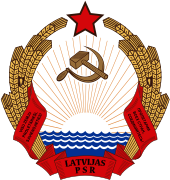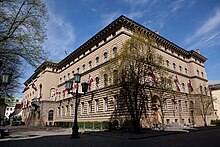This article has multiple issues. Please help improve it or discuss these issues on the talk page. (Learn how and when to remove these template messages)
|
The Supreme Soviet of the Latvian SSR (Latvian: Latvijas PSR Augstākā Padome; Russian: Верховный Совет Латвийской ССР, Verkhovnyy Sovet Latvyyskoy SSR) was the supreme soviet (main legislative institution) of the Latvian SSR, one of the union republics of the Soviet Union. The Supreme Soviet of the Latvian SSR was established in 1940 and finally disbanded in 1990[2] and was briefly succeeded by the Supreme Council of the Republic of Latvia. According to the 1978 Constitution of the Latvian SSR, representatives could serve an unlimited amount of 5-year terms.[3] The Supreme Soviet consisted of 325 deputies before its dissolution.
Supreme Soviet of the Latvian SSR | |
|---|---|

| |
| Type | |
| Type | |
| History | |
| Established | 1940 1947 (Re-established) |
| Disbanded | 1941 (Nazi occupation) 1990 |
| Preceded by | People's Parliament |
| Succeeded by | Supreme Council of the Republic of Latvia |
| Leadership | |
Chairman | Anatolijs Gorbunovs (last) |
Chairman of the Presidium | Anatolijs Gorbunovs (last) |
| Elections | |
Last election | 1990 |
| Meeting place | |
 | |
| House of the Livonian Noble Corporation, Riga, Latvian SSR, Soviet Union | |
The structure and functions of the Supreme Soviet of the Latvian SSR were copied from the Supreme Soviet of the Soviet Union. The sessions of the Supreme Soviet lasted only several days twice a year and decisions were made unanimously and without much discussion. Elections for the Supreme Soviet were held in 1947, 1951, 1955, 1959, 1963, 1967, 1971, 1975, 1980, 1985, and 1990. The amount of deputies in the Supreme Soviet was increased from 310 to 325 in the 1978 Constitution of the Latvian SSR. The Supreme Soviet of the Latvian SSR gathered and met at the House of the Livonian Noble Corporation; the building currently houses the Saeima of Latvia.
| Portrait | Chairman | From | To |
|---|---|---|---|
| Alexander Masecis | 25 August 1940 | 14 October 1948 | |
| Peteris Zvaigzne | 14 October 1948 | 1953 | |
| Edgar Apinis | 1956 | 1957 | |
| Janis Vanags | 5 June 1957 | 20 March 1963 | |
| Peteris Valeskalns | 20 March 1963 | 7 July 1971 | |
| Alesandrs Malmeisters | 7 July 1971 | 3 July 1975 | |
| Valentina Klibik | 3 July 1975 | 29 March 1985 | |
| Alexander Drizul | 29 March 1985 | 27 July 1989 | |
| Anatolijs Gorbunovs | 27 July 1989 | 4 May 1990 |
| Portrait | Chairman | From | To |
|---|---|---|---|
| Augusts Kirhenšteins | 25 August 1940 | 10 March 1952 | |
| Karlis Ozolins | 10 March 1952 | 27 November 1959 | |
| Janis Kalnberzins | 27 November 1959 | 5 May 1970 | |
| Vitālijs Rubenis | 5 May 1970 | 20 August 1974 | |
| Peteris Strautmanis | 20 August 1974 | 22 July 1985 | |
| Janis Vagris | 22 July 1985 | 6 October 1988 | |
| Anatolijs Gorbunovs | 6 October 1988 | 4 May 1990 |